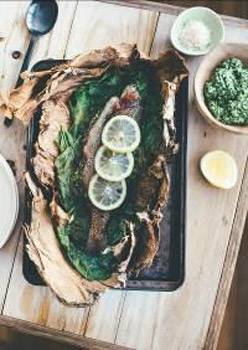Paperbark Wrapped Rainbow Trout Stuffed with Warrigal Green Macadamia Pesto

Paperbark Wrapped Rainbow Trout Stuffed with Warrigal Green Macadamia Pesto
Serves 4 with 1½ cups pesto
Paperbark imparts a smoky flavour when heated, makingthe rainbow trout taste absolutely amazing.
Ingredients
Pesto
4 cups warrigal greens, firmly packed (see note)
½ cup macadamias, roasted
2 cloves garlic, roughly chopped
1½ tablespoons lemon juice
½ cup Parmesan cheese, grated
1/3 cup macadamia oil
Rainbow trout
2 teaspoons lemon myrtle
½ cup macadamia oil
4 x 300g small whole rainbow trout, cleaned and scaled
4 large sheets paperbark
warrigal greens, to line paperbark
2 lemons, sliced
Method
To make the pesto, blanch the warrigal greens in a pan of boiling water for 2 minutes.
Refresh in a bowl of iced water. Squeeze out any excess water and roughly chop.
In a food processor blend the warrigal greens, macadamias and garlic, scraping down the sides, until almost smooth. Add the Parmesan and with the motor running, add the lemon juice and macadamia oil in a slow steady stream and process until well combined. Season with salt and pepper to taste. Set aside.
Preheat the oven to 180°C. Combine the lemon myrtle and macadamia oil and brush all over the fish. Dampen each piece of paperbark and line with warrigal greens. Place the trout on top and fill each fish cavity with 2 to 3 tablespoons of warrigal macadamia pesto. Place
lemon slices on top of the trout.
Trim the edges of the bark with scissors then wrap up into a bon bon shape, allowing a little opening for steam to escape. Use cooking string to tie each end of the bark.
Place the trout parcels on 2 baking trays, sprinkle with water, cover with foil and bake for 20 minutes or until the fish is cooked.
Tips:
You can substitute warrigal greens for English spinach but no need to blanch them
You can substitute paperbark for non-stick baking paper. Paperbark is available from specialty or online stores.
You can barbeque your trout on a high heat, cooking for 10 minutes on each side or until the fish is cooked
Note: Warrigal Greens were one of the first native Australian vegetables to become popular with European settlers. Looking for ways to fight scurvy, Captain Cook encouraged his men to eat them, and many convicts owed their lives to the spinach-like plant. The plant was
taken back to England by the botanist Joseph Banks and became popular there for a time.
What better way to celebrate our national day than with a helping of Australia's native nut to add a fair-dinkum Aussie twist to backyard BBQs or lazy picnics with friends.
CEO of Australian Macadamia Society, Jolyon Burnett, said Australia Day is all about celebrating our beautiful country and there's nothing more -true blue' than home-grown macadamias.
'Our passionate growers work tirelessly all year round to create the world's finest nut. There's nothing like the creamy, buttery taste and crunchy texture of Australian macadamias and we should be proud of that. We want Aussies to embrace the local produce that makes this country so special," Mr Burnett said.
Macadamias are predominantly grown in the Northern Rivers region of New South Wales and along the Queensland coast, with smaller plantings in Western Australia. Around 45,000 tonnes are produced annually with blossoming beginning in late August, harvest in February and March and new season nuts are on shelf from May each year.
Once at home, macadamias will keep for some time in an air-tight container in the fridge – that's if you can resist them!
MORE





